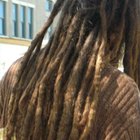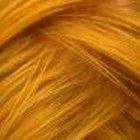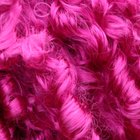
Dreadlocks are a hairstyle in which sections of hair are purposely matted into rope-like lengths. Although the word "dreadlocks" is attributed to Jamaican Rastafarians, dreadlocks have been around for centuries and were not invented by Jamaicans. Written evidence states that Julius Caesar referred to the Celts as having "hair like snakes." You can wear dreadlocks as a part of your Rastafarian faith, or simply as fashion.
Work on clean, dry hair. Section hair into 1-inch or slightly smaller squares, using a comb. Note that smaller sections will produce thinner dreads. Secure sections temporarily with elastic hairbands. Complete sectioning of all hair.
Use a dread comb to backcomb the hair of the first section backwards toward the roots. Backcombing is combing the hair in the opposite of the direction of natural growth, and is also known as teasing. Start as close to the scalp as possible. Continue combing in this manner until the hair starts to pack in tightly at the roots.
Roll the width of each dreadlock between your fingers as you backcomb. Start at the roots and work slowly and deliberately toward the ends. Continue to the end of the hair.
Make the dreads as tight as you can. Secure the end of each dreadlock with an elastic band. Continue to work in this manner until all hair is backcombed and secured. Replace the elastic bands, securing the hair near the scalp. This will aid in keeping dreads tight until they mature.
Apply dread wax. Start with about 1/4 ounce. Warm the wax by rubbing it between your forefinger and thumb. Start about ½ inch from the scalp and rub the wax into the dread, rolling your fingers as you go. Add more wax when the first portion has been worked into the hair. Continue in this fashion and work toward the end of each dreadlock. Repeat for each dread.
Use soap to keep dreads clean and reapply wax as needed. Dreads that are well cared for mature more quickly. Rub the root of stubborn dreads in a clockwise direction to help them form and lock.
Related Articles

How to Dreadlock a Beard

How to Unlock Dreads

How to Apply Schwarzkopf Taft Hair Wax

How to Do Tight Braids

How to Wash African-American Braids

How to Sew in Dreads

How to Dreadlock Thin Straight Hair

Old-Fashioned Ways to Curl Long Hair

How to Get the Look of Dreads Without ...

How to Use Velcro Rollers So They Don't ...

How to Make Dreadlocks

How to Keep New Dreads Tight

How to Get Hair Ready for Braids

How to Part Your Hair in a Zigzag

How to Make a Grecian Braid

How to Manage Thick, Coarse ...

How to Make a Straight Wig Curly

Removing Hair Extensions With Acetone

How to Do an English Braid

How to Braid from the Root
References
Writer Bio
Based in central New York, Laura Slivinski has been writing and reviewing technical reports since 1999. She attended Onondaga Community College and Syracuse University and was a private investigator for many years. Slivinski is certified as an email tracing investigator, a wireless security investigator and a Level II insurance fraud investigator.
Photo Credits
Jupiterimages/Polka Dot/Getty Images